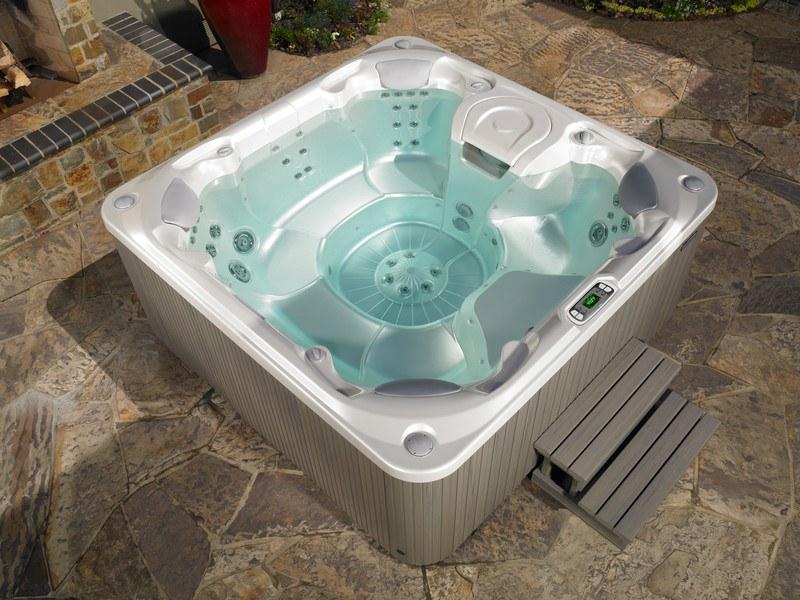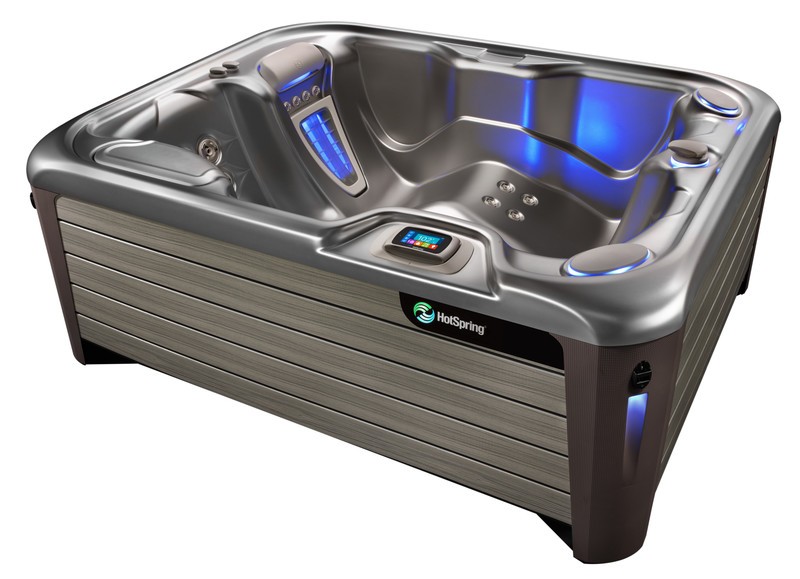
Your hot tub's shell keeps your water contained inside your tub; it's also a key determining factor in how well your spa retains heat. As the surface of your hot tub presents to the world, the shell must be strong enough to stand up to mishaps and to withstand years of regular use. If aesthetic concerns are important to you, it must be visually appealing as well as highly functional. Hot tub shells come in a variety of materials, each possessing their own strengths and weaknesses. Learning more about what hot tub shells are made of can give you a better idea about which hot tub would be best suited for your needs.

Until the 1970s, hot tub shells were primarily constructed out of wood. Today, only a few manufacturers continue to craft shells this way; these days, a typical hot tub shell is most likely to be made from vinyl, rotomolded plastic, or acrylic. Hot tubs can also be constructed from cement, stainless steel, fiberglass, or inflatable PVC, though these are less common.
HOT TUB SHELLS MADE FROM VINYL
Some hot tubs are constructed through a process in which a vinyl liner is placed over a frame made from another material, such as cement. This is the same method that's frequently used in the manufacturing of swimming pools. Vinyl liner hot tubs are commonly found attached to inground pools; while they're inexpensive to produce, they don't retain heat well. A vinyl liner hot tub may be relatively cheap to purchase, especially if it's part of a package deal with your swimming pool, but what you save on the sticker price may be eaten up by the cost of the electricity it takes to keep your hot tub warm. Vinyl is not an especially durable material; a vinyl hot tub shell is more likely to crack or tear than a shell made from stronger materials. Continuous exposure to sunlight will fade the color of your vinyl hot tub liner, while an incorrect balance of chemicals in your hot tub can damage it.
HOT TUB SHELLS MADE FROM ROTOMOLDED PLASTIC
Rotomolded hot tubs are made from plastic powder, which is added to a mold, heated until it melts, and then rotated until it covers every bit of the mold in a smooth and even layer. Unlike the glossy surface of acrylic shells, rotomolded plastic shells have a dull matte finish. Compared to acrylic shells, plastic shells are relatively lightweight. This results in a lighter and more easily transportable hot tub, which may give you more options as to where it may be placed in your yard or on your deck. The downside, however, is an inability to efficiently retain heat. As with hot tubs built with vinyl liners, the initial savings from their lower purchase price will be eroded over time, as owners of rotomolded hot tubs typically pay more in electricity than owners of more energy-efficient spas.
HOT TUB SHELLS MADE FROM ACRYLIC
An acrylic hot tub shell is made from a single sheet of acrylic, which is heated until it begins to melt, then placed over a mold. Vacuums help suck away any air trapped between the mold and the acrylic sheet, resulting in a smooth and perfectly formed shell. After the acrylic has cooled and hardened, it's reinforced with a combination of resin and fiberglass to give it additional strength. Some acrylic shells are formed through a variant process in which a layer of the polymer acrylonitrile butadiene styrene, known as ABS, is pre applied to the sheet before molding. The resulting hot tub shell is durable, energy efficient, and aesthetically pleasing. This video provides an overview of the way in which acrylic shells are formed.
If you own an acrylic hot tub, expect it to withstand normal wear and tear for many years without showing signs of damage. Acrylic hot tubs are produced in a variety of stunning colors and patterns. Also, acrylic hot tubs retain their heat very well when insulated with a high-quality material such as multi-density foam or FiberCor®.

Acrylic hot tubs are heavier than rotomolded hot tubs. As they can't be easily repositioned, they work best as a permanent installation in your backyard or on your deck. While acrylic tubs are more expensive than vinyl or plastic tubs, their excellent temperature retention translates to lower energy needs than other hot tubs. This in turn reduces the ongoing cost of the electricity needed to keep your water hot.
While hot tub shells made of other materials have some advantages, hot tubs with acrylic shells are the connoisseur's choice, aimed at those who value quality, performance, and appearance. For a better idea of which hot tub shell would be best for you, visit your local hot tub dealer. Your dealer can answer all your questions about energy costs and durability; you may even be able to take a test soak. When purchasing a hot tub, many decisions are involved, such as determining which shell material would work best for your lifestyle. Your hot tub dealer can help you find the solution that works best for you.

Hot Spring Spas is dedicated to offering the absolute highest quality hot tubs available to our customers. Our top-of-the-line Highlife and Highlife NXT hot tub collections feature attractive, durable, energy-efficient acrylic shells in a variety of colors. We build with acrylic to give out customers the peace of mind that comes from knowing their hot tub investment will pay them back for years and years. To learn more about which hot tub is right for you and your family, download our brochure.